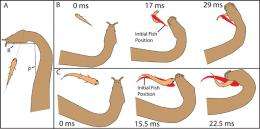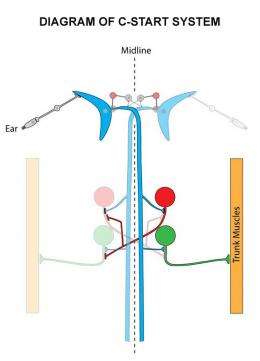A water snake that predicts which way fish will turn when it attacks

Forget the old folk tales about snakes hypnotizing their prey. The tentacled snake from South East Asia has developed a more effective technique. The small water snake has found a way to startle its prey so that the fish turn toward the snake's head to flee instead of turning away. In addition, the fish's reaction is so predictable that the snake actually aims its strike at the position where the fish's head will be instead of tracking its actual movement.
"I haven't been able to find reports of any other predators that exhibit a similar ability to influence and predict the future behavior of their prey," says Kenneth Catania, associate professor of biological sciences at Vanderbilt University, who has used high-speed video to deconstruct the snake's unusual hunting technique.

His observations are published this week in the online early edition of the Proceedings of the National Academy of Sciences.
Catania, who is the recipient of a MacArthur "genius” award, studies the brains and behavior of species with extreme specializations. He was attracted to the tentacled snake because it is the only snake that comes equipped with a pair of short tentacles on its nose and he was curious about their function.
"Before I begin a study on a new species, it is my practice to spend some time simply observing its basic behavior,” Catania explains. The snake forms an unusual "J” shape with its head at the bottom of the "J” when it is fishing. Then it remains completely motionless until a fish swims into the area near the hook of the "J.” That is when the snake strikes.
The snakes' motions take only a few hundredths of a second and are too fast for the human eye to follow. However, its prey reacts even faster, in a few thousandths of a second. In fact, fish are famous for the rapidity of their escape response and it has been extensively studied. These studies have found that many fish have a special circuit in their brains that initiates the escape, which biologists call the "C-start.” Fish ears sense the sound pressure on each side of their body. When the ear on one side detects a disturbance, it sends a message to the fishes' muscles causing its body to bend into a C-shape facing in the opposite direction so it can swim away from danger as quickly as possible
Catania is the first scientist to study this particular predator-prey interaction with the aid of a high-speed video camera. When he began examining the movements of the snake and its prey in slow motion, he saw something peculiar. When the fish that the snake targets turn to flee, most of them turn toward the snake's head and many literally swim into its jaws! In 120 trials with four different snakes, in fact, he discovered that an amazing 78 percent of the fish turned toward the snake's head instead of turning away.
Next, the biologist noticed that the first part of its body that the snake moves is not its head. Instead, it flexes a point midway down its body. Using a sensitive hydrophone that he put in the aquarium, he confirmed that this body fake produces sound waves intense enough to trigger the fish's C-start response. Because these sound waves come from the side opposite the snake's head, this reflex action drives the fish to turn and swim directly toward the snake's mouth.
"Once the C-start begins, the fish can't turn back,” Catania says. "The snake has found a way to use the fish's escape reflex to its advantage.”
As he studied the snake's actions even closer, he made an even more remarkable discovery. When it strikes, the snake doesn't aim for the fish's initial position and then adjust its direction as the fish moves — the way most predators do. Instead it heads directly for the location where it expects the fish's head to be.
"The best evidence for this is the cases when the snake misses,” says Catania. "Not all the targeted fish react with a C-start and the snake almost always misses those that don't react reflexively.”
Catania's next step will be to determine whether this predictive capability is hard-wired or learned. To do so, he hopes to obtain some baby snakes that have just hatched and videotape their first efforts to catch prey.
Click to view the high-speed video
Source: Vanderbilt University (news : web)















